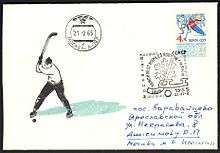First day of issue

A first day of issue cover or first day cover (FDC) is a postage stamp on a cover, postal card or stamped envelope franked on the first day the issue is authorized for use[1] within the country or territory of the stamp-issuing authority. Sometimes the issue is made from a temporary or permanent foreign or overseas office. There will usually be a first day of issue postmark, frequently a pictorial cancellation, indicating the city and date where the item was first issued, and "first day of issue" is often used to refer to this postmark. Depending on the policy of the nation issuing the stamp, official first day postmarks may sometimes be applied to covers weeks or months after the date indicated.
Postal authorities may hold a first day ceremony to generate publicity for the new issue, with postal officials revealing the stamp, and with connected persons in attendance, such as descendants of the person being honored by the stamp. The ceremony may also be held in a location that has a special connection with the stamp's subject, such as the birthplace of a social movement, or at a stamp show.
Other types of first day covers
Computer vended postage stamps issued by Neopost had first-day-of-issue ceremonies sponsored by the company, not by an official stamp-issuing entity.[2] Personalised postage stamps of different designs are sometimes also given first-day-of-issue ceremonies and cancellations by the private designer. The stamps issued by private local posts can also have first days of issue, as can artistamps.
Event covers

Event covers, instead of marking the issuance of a stamp, commemorate events. A design on the left side of the envelope (a "cachet") explains the event or anniversary being celebrated. Ideally the stamp or stamps affixed relate to the event. Cancels are obtained either from the location (e.g., Cape Canaveral, Anytown) or, in the case of the United States, from the Postal Service's Cancellation Services unit in Kansas City.
Earliest known use
The earliest known use (EKU) of a stamp may or may not be the same as the first day of issue. This can occur if:
- Stamps are inadvertently sold or stolen, and cancelled on an envelope or package by unaware postal officials prior to the first day of issue.
- Minor changes, such as a different perforation, are noted by postal officials, and no one knows when they first went on sale. This is also true of some major stamp issues, especially during periods of civil unrest or if government records have been lost.
- Some earlier stamps, especially high values, have not found any customers using them on the day of issue, or those uses have been lost. EKUs for these may be weeks or even months after the official first day.
- Some stamps have not have had an officially designated first day of issue and instead were simply placed on sale whenever the stamps were needed.
The search for EKUs of both old and new stamps is an active area of philately, and new discoveries are regularly announced.
Philatelic covers

As the collecting of first day covers became more popular they began to appear on prepared envelopes, often with an illustration (commonly referred to by collectors as a cachet) that corresponded with the theme of the stamp.[3] Several printing companies began producing such envelopes and often hired free lance illustrators to design their cachets such as Charles R. Chickering who in his earlier years designed postage stamps for the U.S. Post Office.[4]
See also
Earliest Reported Postmark on stamped envelopes.
References
- ↑ Bennett, Russell and Watson, James; Philatelic Terms Illustrated, Stanley Gibbons Publications, London (1978)
- ↑ Neopost Covers
- ↑ Hudgeons, 2009, pp.592-609
- ↑ Lerner, 2010, pp.10-11
Sources
- Hudgeons, Marc (et al) (2009). The Official Blackbook Price Guide to United States Postage Stamps 2010.
Random House LLC. p. 656. ISBN 9780375723247.
| Wikimedia Commons has media related to First day covers. |